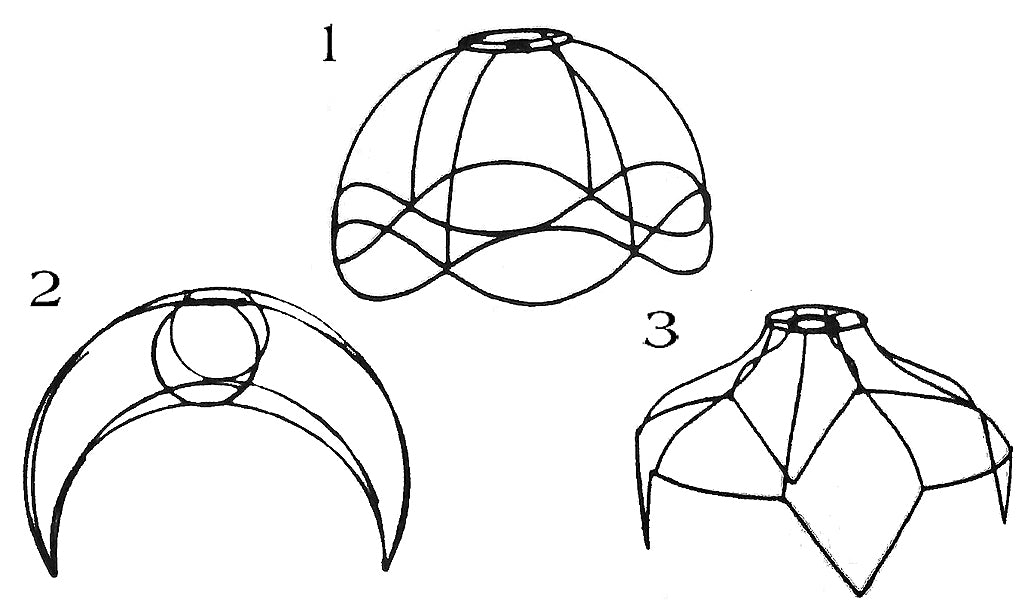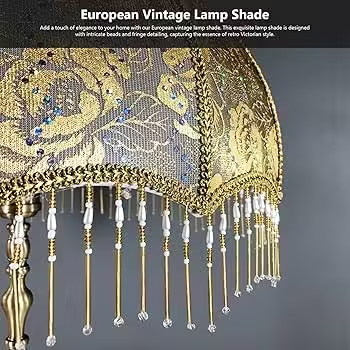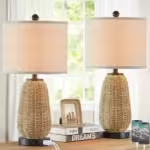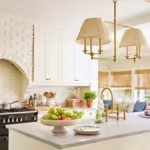Victorian lampshade frames add a touch of elegance and history to any room. They are ornate, intricate, and timeless.
Victorian lampshade frames are known for their exquisite craftsmanship and detailed designs. These frames often feature intricate patterns, delicate lace, and rich fabrics. They bring a nostalgic charm and sophistication to any interior decor. Perfect for vintage or antique settings, these lampshades can transform a simple lamp into a stunning centerpiece.
Their unique designs are inspired by the Victorian era, reflecting the opulence and grandeur of that time. Whether you are a collector or just love vintage aesthetics, Victorian lampshade frames offer a beautiful way to enhance your home’s ambiance.

Credit: www.lampshop.com
History Of Victorian Lampshade Frames
The Victorian era is well-known for its unique and ornate design styles. One of the intriguing elements from this period is the Victorian lampshade frame. These frames not only served a functional purpose but also added a touch of elegance and sophistication to any room. The history of Victorian lampshade frames is rich and fascinating, spanning various phases of design and material use.
Origins And Evolution
Victorian lampshade frames originated in the 19th century, during the reign of Queen Victoria. The Industrial Revolution played a significant role in their development. With the advent of gas and electric lighting, there was a need for more decorative lighting solutions.
Initially, lampshades were simple and utilitarian. Over time, they evolved into more elaborate designs. Victorian homes were known for their opulence, and lampshade frames followed suit. They became more intricate, featuring elaborate shapes and patterns.
Key Stages of Evolution:
- Early Designs: Basic frames made from wire and covered with fabric or paper.
- Mid-Victorian Era: Introduction of more decorative elements like fringes and beading.
- Late Victorian Era: Use of luxurious materials and complex designs, often inspired by nature and art.
Victorian lampshade frames also reflected the changing tastes and advancements in manufacturing techniques. By the end of the Victorian era, they had become a symbol of luxury and craftsmanship.
Materials And Techniques
The materials and techniques used in making Victorian lampshade frames were as varied as the designs themselves. Early frames were typically made from simple wire. As technology advanced, more materials were introduced.
Common Materials:
| Material | Description |
|---|---|
| Wire | Basic structure, often covered with fabric. |
| Brass | Used for its durability and decorative appeal. |
| Iron | Provided a sturdy frame for larger lampshades. |
The techniques used to create these frames were also quite varied. Handcrafting was a common method, allowing artisans to create intricate designs. Welding and soldering were used to join metal parts securely.
Decorative Techniques:
- Beading: Adding beads for a sparkling effect.
- Fringing: Attaching fringes to the edges for added elegance.
- Embroidery: Using thread to create intricate patterns on the fabric covering.
These techniques and materials combined to create lampshade frames that were not only functional but also works of art. Each frame was unique, reflecting the skills and creativity of its maker.

Credit: lampshadelady.com
Design Elements
Victorian lampshade frames bring a touch of elegance and timeless beauty to any room. Their intricate design elements make them stand out and add a unique charm. From delicate metalwork to ornate embellishments, these frames capture the essence of the Victorian era.
Intricate Metalwork
The first thing you notice about Victorian lampshade frames is their intricate metalwork. Craftsmen of the era paid great attention to detail, creating designs that are both beautiful and functional. These frames often feature:
- Delicate scrolls: These add a touch of whimsy and elegance.
- Floral motifs: Common in Victorian design, bringing nature indoors.
- Geometric patterns: Offering a balanced and structured look.
Many Victorian lampshade frames are made from high-quality metals like brass and iron. These metals are not only durable but also lend a luxurious feel to the lampshade. The metal is often shaped using hand tools, making each piece unique. This craftsmanship is a testament to the skill and dedication of the artisans.
Here is a table showcasing some common metalwork patterns and their features:
| Pattern | Features |
|---|---|
| Scrolls | Whimsical, elegant, delicate |
| Floral Motifs | Natural, intricate, detailed |
| Geometric Patterns | Structured, balanced, symmetrical |
These elements make Victorian lampshade frames not just lighting fixtures but also works of art. They can transform a simple lamp into a statement piece, adding a touch of historical elegance to your home.
Decorative Embellishments
Victorian lampshade frames are known for their decorative embellishments. These details add a layer of sophistication and charm to the frames. Some common embellishments include:
- Beaded fringes: These add a touch of sparkle and movement.
- Fabric trims: They enhance the overall look and are often made from lace or silk.
- Painted finishes: These can include gold leaf or patina for an antique look.
The embellishments are not just for decoration; they also serve to hide the joints and seams of the metal frame. This gives the lampshade a polished and cohesive look. The use of high-quality materials in these embellishments ensures they stand the test of time.
Here’s a list of popular decorative materials used in Victorian lampshade frames:
- Silk: Luxurious and elegant.
- Lace: Delicate and intricate.
- Beads: Sparkling and eye-catching.
These materials were chosen for their beauty and durability. They add a tactile element to the lampshade, making it as enjoyable to touch as it is to look at. The combination of intricate metalwork and decorative embellishments makes Victorian lampshade frames a timeless addition to any home.
Types Of Victorian Lampshade Frames
Victorian lampshade frames offer a touch of elegance and historical charm to any room. These frames come in various styles, each adding a unique aesthetic appeal. Understanding the types of Victorian lampshade frames helps you choose the perfect frame for your decor. Let’s explore some of the most popular types: Bell-Shaped Frames, Empire Frames, and Coolie Frames.
Bell-shaped Frames
Bell-shaped frames are among the most iconic Victorian lampshade frames. They are known for their graceful, flared bottom that resembles a bell. These frames are perfect for creating a soft, ambient light in any room.
- Elegant Design: The flared design adds a touch of sophistication.
- Soft Lighting: The shape helps diffuse light, creating a warm glow.
- Versatile: Suitable for various decor styles, from traditional to eclectic.
Here is a quick comparison of the features of bell-shaped frames:
| Feature | Description |
|---|---|
| Shape | Flared bottom, narrow top |
| Light Diffusion | Creates a soft, ambient light |
| Decor Compatibility | Works with various styles |
Empire Frames
Empire frames are another popular choice for Victorian lampshades. They have a more structured and symmetrical design, often wider at the bottom and narrower at the top. This type of frame offers a classic and timeless look.
- Timeless Appeal: The structured design makes it a classic choice.
- Strong Lines: Features clean, strong lines for a more formal look.
- Wide Base: Provides stability and a broader light spread.
Here is a quick comparison of the features of Empire frames:
| Feature | Description |
|---|---|
| Shape | Wide bottom, narrow top |
| Light Diffusion | Offers a broader light spread |
| Decor Compatibility | Best for formal and classic settings |
Coolie Frames
Coolie frames are distinct for their wide, flat shape that resembles a traditional Asian hat. They offer a unique and stylish look that can complement various decor themes, from vintage to modern.
- Unique Shape: The flat, wide shape stands out.
- Directional Light: Directs light downwards, ideal for task lighting.
- Stylish Appeal: Adds a unique, stylish touch to any room.
Here is a quick comparison of the features of Coolie frames:
| Feature | Description |
|---|---|
| Shape | Wide and flat |
| Light Diffusion | Directs light downwards |
| Decor Compatibility | Versatile, works with various themes |
Popular Fabrics And Trimmings
Victorian lampshade frames are known for their elegance and intricate designs. A key aspect that enhances their charm is the choice of fabrics and trimmings. These elements add character and sophistication to any lampshade. Understanding the popular fabrics and trimmings helps in selecting the right style for your home.
Silk And Brocade Fabrics
Silk and brocade fabrics are the go-to materials for Victorian lampshades. These fabrics exude luxury and elevate the overall look of the lampshade. The smooth texture of silk provides a soft glow when the lamp is lit, creating a warm and inviting ambiance. Silk is available in various colors and patterns, making it versatile for different decor styles.
Brocade fabric, known for its rich texture and intricate patterns, adds a touch of opulence. It often features raised designs, which can include floral patterns, geometric shapes, or even historical scenes. Brocade is typically woven with gold or silver threads, adding a metallic sheen that catches the light beautifully.
Here are some key features of these fabrics:
- Silk: Smooth, luxurious, available in many colors.
- Brocade: Textured, intricate patterns, often with metallic threads.
A comparison of these fabrics can be summarized in the table below:
| Fabric | Texture | Patterns | Luxurious Feel |
|---|---|---|---|
| Silk | Smooth | Various | High |
| Brocade | Textured | Intricate | Very High |
Fringes And Tassels
Fringes and tassels are classic trimmings that add a finishing touch to Victorian lampshades. These elements are not just decorative; they also enhance the overall aesthetic appeal. Fringes consist of hanging threads or strips of fabric that create a playful, yet elegant look. They can be short or long, depending on the desired effect.
Tassels are another popular trimming. They are often used at the edges of the lampshade to add a touch of sophistication. Tassels can be made from various materials, including silk, cotton, and even beads. They come in different shapes and sizes, allowing for customization to match the lampshade’s design.
Here are some characteristics of fringes and tassels:
- Fringes: Hanging threads, playful and elegant, of various lengths.
- Tassels: Decorative knots, various materials, different shapes and sizes.
The table below highlights the key aspects of fringes and tassels:
| Trimming | Material | Appearance | Usage |
|---|---|---|---|
| Fringes | Fabric threads | Hanging, playful | Edges of lampshades |
| Tassels | Silk, cotton, beads | Knotted, decorative | Edges and corners |
Role In Victorian Interior Decor
Victorian lampshade frames played a significant role in Victorian interior decor. These intricate frames were not just functional; they added a touch of elegance to any room. They reflected the era’s love for ornate designs and fine craftsmanship. Victorian lampshades, with their unique shapes and detailed embellishments, were key elements in creating the period’s distinctive ambiance.
Ambient Lighting
Victorian lampshades contributed greatly to ambient lighting. They provided a soft, warm glow that enhanced the cozy atmosphere. The frames often featured intricate patterns, which cast beautiful shadows across the room. This effect was both functional and decorative.
Key features of ambient lighting with Victorian lampshades:
- Soft, diffused light: Creates a welcoming environment.
- Patterned shadows: Adds visual interest to walls and ceilings.
- Variety of materials: Silk, lace, and velvet were popular choices.
- Colorful embellishments: Beads, fringes, and tassels provided extra charm.
Victorian lampshades often used rich colors like deep reds, greens, and golds. These colors enhanced the warm lighting effect. The combination of light and color created a luxurious feel. Here is a brief table highlighting some common materials and their impact on lighting:
| Material | Lighting Effect |
|---|---|
| Silk | Soft, elegant glow |
| Lace | Delicate, intricate shadows |
| Velvet | Rich, warm light |
Statement Pieces
Victorian lampshade frames were often statement pieces in a room. They drew attention and showcased the homeowner’s taste. These frames were not only functional but also a form of art. Their designs ranged from simple and elegant to grand and elaborate.
Characteristics of Victorian statement lampshades:
- Intricate designs: Detailed patterns and motifs.
- Luxurious materials: High-quality fabrics and embellishments.
- Unique shapes: Bell-shaped, empire, and pagoda styles.
- Decorative elements: Beads, fringes, and appliqués.
These lampshades often became focal points in a room. They matched well with other Victorian decor elements, like heavy drapes and upholstered furniture. The craftsmanship involved in making these lampshades was remarkable. Each piece was a testament to the skill and creativity of Victorian artisans.
Popular Victorian lampshade styles include:
- Bell-shaped: Elegant curves, often with fringes.
- Empire: Tapered shape, sophisticated look.
- Pagoda: Exotic, unique silhouette.
Victorian lampshades added a touch of grandeur to any space. They were more than just light fixtures; they were works of art. The attention to detail and quality made them timeless pieces that continue to inspire interior decor today.

Credit: www.pinterest.com
Restoring And Repurposing Victorian Lampshade Frames
Victorian lampshade frames are beautiful and intricate. They add a touch of elegance to any room. Restoring and repurposing these frames can bring back their lost charm. This blog post will explore methods to preserve these frames and creative ways to upcycle them.
Preservation Techniques
Preserving Victorian lampshade frames ensures they last for years. Follow these simple techniques to keep them in good condition:
- Cleaning: Use a soft brush to remove dust and dirt. Avoid harsh chemicals. A damp cloth can be used for stubborn stains.
- Rust Removal: Use a mixture of vinegar and baking soda. Apply it to rusty areas and scrub gently. Rinse with water and dry completely.
- Repainting: Choose a paint suitable for metal. Apply a primer first. Then, add two coats of paint for a smooth finish.
- Rewiring: Hire a professional electrician. Ensure the wiring is safe and up to code.
Here is a table summarizing the tools needed for preservation:
| Task | Tools Needed |
|---|---|
| Cleaning | Soft brush, damp cloth |
| Rust Removal | Vinegar, baking soda, scrub brush |
| Repainting | Primer, paint, brushes |
| Rewiring | Electrician tools |
Creative Upcycling Ideas
Repurposing Victorian lampshade frames can create unique decor pieces. Here are some creative ideas:
- Hanging Planters: Turn the frame upside down. Attach small pots with chains. Fill them with your favorite plants.
- Photo Display: Remove the fabric. Use clothespins to attach photos to the frame. Hang it on a wall for a vintage photo display.
- Jewelry Organizer: Add hooks to the frame. Hang necklaces, bracelets, and earrings. This keeps your jewelry organized and easy to find.
- Chandelier: Attach small LED lights. Hang the frame from the ceiling. This creates a stunning chandelier.
These ideas not only give new life to old frames but also add a unique touch to your home decor. Upcycling is a sustainable way to enjoy vintage beauty. Get creative and have fun with your projects!
Collecting And Valuing Victorian Lampshade Frames
Victorian lampshade frames are more than just functional items; they are relics of an era known for their distinct and elegant design. Collecting and valuing these frames can be a rewarding hobby. These frames often exhibit intricate craftsmanship, making them sought-after collectibles. Understanding their unique features and their market value can help collectors make informed decisions.
Identifying Rare Pieces
Identifying rare Victorian lampshade frames involves paying close attention to specific details. These frames often feature intricate designs and high-quality materials.
- Material: Rare frames are often made from brass or iron, which was common in the Victorian era.
- Design: Look for unique patterns, such as floral or geometric designs, which indicate a higher level of craftsmanship.
- Condition: Frames in excellent condition are more valuable. Check for rust, missing parts, or any signs of wear.
- Maker’s Mark: Some frames may have a maker’s mark or signature, adding to their rarity and value.
Below is a table summarizing the key factors to look for:
| Factor | Description |
|---|---|
| Material | Brass, iron, or other high-quality metals |
| Design | Floral, geometric, or other intricate patterns |
| Condition | Excellent condition with minimal wear |
| Maker’s Mark | Signature or mark from the creator |
Appraisal And Market Trends
Appraising Victorian lampshade frames requires knowledge of current market trends and historical value.
Research: Study recent sales and auction results to understand the current market value of similar items.
Professional Appraisal: Seek a professional appraisal for a more accurate valuation. Experts can provide insights into the frame’s history and rarity.
Market Trends: The market for Victorian lampshade frames can fluctuate. Keep an eye on trends to determine the best time to buy or sell.
Here are some current market trends:
- Increasing Demand: There is a growing interest in Victorian antiques, including lampshade frames.
- Online Sales: More collectors are buying and selling online, which can affect prices.
- Condition Matters: Frames in pristine condition fetch higher prices.
Staying informed about these trends helps collectors make better decisions.
Diy Projects With Victorian Lampshade Frames
Victorian lampshade frames add a touch of elegance and charm to any home. These vintage frames are perfect for DIY projects, allowing you to create custom décor pieces that reflect your personal style. Whether you want to make a unique lampshade or craft other home décor items, Victorian lampshade frames offer endless possibilities for creativity.
Custom Lampshade Making
Creating a custom lampshade with a Victorian frame is a fun and rewarding project. Start by selecting a frame that suits your design. Victorian frames come in various shapes, including bell, empires, and pagodas.
Next, choose your fabric. Consider rich, textured materials such as velvet, silk, or brocade. These fabrics complement the ornate design of the frame. Here’s a simple step-by-step guide:
- Measure the frame: Take precise measurements of the frame’s height, width, and circumference.
- Cut the fabric: Cut your chosen fabric according to the measurements, adding a small allowance for seams.
- Sew the fabric: Sew the fabric pieces together, creating a cover that fits snugly over the frame.
- Attach the cover: Secure the fabric cover to the frame using fabric glue or a hot glue gun.
- Add embellishments: Enhance your lampshade with fringe, beads, or lace for an authentic Victorian look.
Your custom lampshade is now ready to brighten up any room with its unique charm.
Crafting Home Décor
Victorian lampshade frames are not just for lampshades. They can be used to create a variety of home décor items that add a vintage touch to your space. Here are some creative ideas:
- Wall Art: Use the frame as a base for a wall art piece. Wrap it in fabric, lace, or ribbons and hang it on the wall.
- Photo Frame: Turn a small lampshade frame into a unique photo frame. Attach a backing and insert your favorite photo.
- Table Centerpiece: Decorate a frame with flowers, beads, and candles to create a stunning table centerpiece.
- Plant Holder: Use the frame as a decorative plant holder. Drape it with vines or small potted plants.
With a little imagination, Victorian lampshade frames can transform into beautiful and functional décor pieces. They add a touch of vintage elegance to any home, making your DIY projects truly special.
Frequently Asked Questions
What Fabric Is Best For Victorian Lampshades?
Silk is the best fabric for Victorian lampshades. Velvet also works well. Both materials provide a luxurious, authentic look.
What Are The 3 Types Of Lampshades?
There are three main types of lampshades: drum, empire, and bell. Drum shades are cylindrical. Empire shades have a wider bottom. Bell shades feature a flared design.
What Is The Rule For Lampshades?
Choose a lampshade that complements the lamp base and room decor. Ensure the shade covers the bulb without exposing it.
What Is The History Of Victorian Lampshades?
Victorian lampshades became popular in the 19th century. They featured ornate designs, rich fabrics, and intricate details. These lampshades often used silk, fringe, and beading. Victorian homes valued their elegance and craftsmanship. Today, they remain a symbol of vintage charm.
Conclusion
Victorian lampshade frames add a timeless elegance to any room. Their intricate designs capture the charm of a bygone era. Whether restoring an antique or creating a vintage look, these frames offer endless possibilities. Embrace their beauty and let your home reflect the grace of Victorian style.



